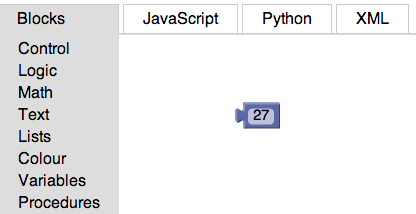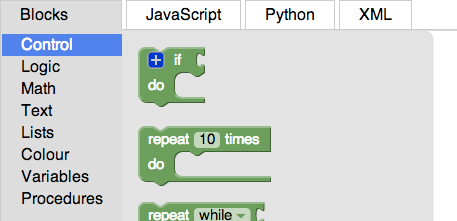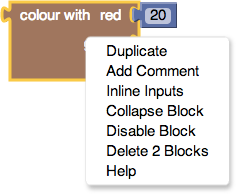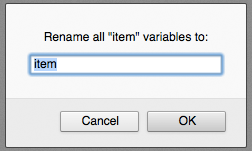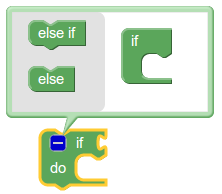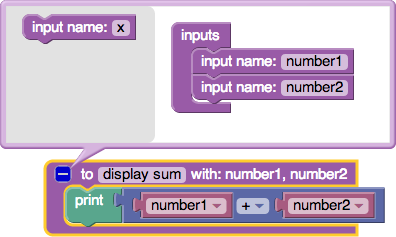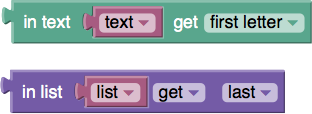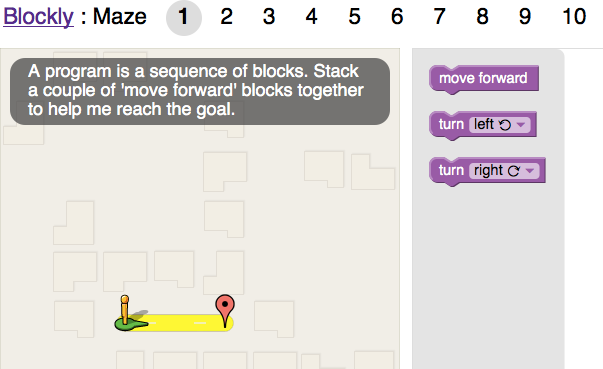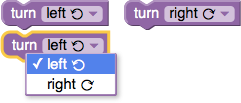Translating:Blockly

Blockly (repository) is an open source project to help people, especially children, learn to program computers. Blockly programs consist of connected "blocks" of code. It consists of:
- an extensible visual programming environment
- a set of educational games for children (or others)
Internationalization, being gender-neutral, and being accessible in a variety of cultures are key priorities.
Contacts: Sean Lip, NeilFraser.
General translation notes
Tense
Our target audience is individual or small groups of children. Please use gender-neutral forms if possible in your language.
Style
The tone is informal and conversational, and we prefer short phrases to long ones, such as "if path ahead" instead of "if there is a path ahead". Translations need not be exact.
Rigor
It is more important that language be clear to beginners than that it matches what experienced programmers use. For example, we use the term "text" instead of "string", and we use "list" instead of "array". A more technical example is that we use 1-based indexing instead of the more common 0-based indexing.
Consistency
Consistency is important. In English, for example, we have gone back and forth on whether to use the term "function" or "procedure". What is more important than which term is chosen is that the same term is used throughout. See Blockly Terms for how key Blockly terms appearing in multiple messages have been translated (if at all) into your language. If agreement among translators cannot be reached, please ask for help.
Symbols
If any mathematical (or other) symbols are inappropriate in your language but are not offered for customization, please let us know.
Special terms
- Blockly
- Our recommendation is that the name of the project be left as is in languages using the Latin alphabet and that it be transliterated in other languages, possibly in parentheses, such as "Blockly (Блoкли)" in Russian.
- block
- Blocks in Blockly programs should be translated as children's building blocks. If that doesn't work in your language, "puzzle piece" is also acceptable.
Plural
Plural formatting is not supported.
Ordinal numbers
Some blocks refer to the nth item in a list or piece of text, where n is an arbitrary number or expression. In English, such a number is preceded by "#", which is included in the messages that precede the space in which the number would go:
Hungarian requires that such numbers or expressions be followed by a dot ("."). A special message ORDINAL_NUMBER_SUFFIX has the value "." for Hungarian and is automatically placed after each ordinal number (but not after the words for "first" or "last", which are already ordinal).
The Hungarian block above also includes a "tail" (final piece of text after the last block). Most languages do not require support for ordinal numbers or for tails, in which case those messages should be the empty string.
The Blockly language
All of the tutorials and applications use a subset or all of the Blockly language, which consists of blocks representing aspects of programming languages, such as control structure, creation of variables and procedures, and library routines. You can play with the blocks at https://blockly-demo.appspot.com/static/demos/code/index.html
The toolbox, workspace, and categories
The below picture shows:
- the toolbox (in grey), which is where the user gets blocks.
- the workspace (in white), which is where the user places blocks to build the program.
In the above picture, the toolbox is closed, and only category names (such as "Control" and "Logic") can be seen. One block is in the workspace. In the below picture, the user has clicked on "Control", causing the category to be expanded and the blocks shown. This screen also has tabs to show the JavaScript, Python, and XML associated with the program in the workspace. Currently, the "Blocks" tab is selected.
Messages associated with blocks
There are many different types of messages associated with blocks, illustrated in the pictures below:
- Block text, such as "colour with" in the below blocks.
- Block input text, such as "red", "green", and "blue", where other blocks can be attached.
- Tooltip, displayed when the user hovers the mouse over a block, shown in a yellow background, as in the picture below. The translator should not insert newline characters ('\n' or <br/>), which are added automatically. Tooltips should be full sentences.
- Context menu, displayed when the user right-clicks on a block, shown in a white background. Please read Context menus below.
- URL, which is opened in another tab when the user clicks on the "Help" context menu item. If the link is to Wikipedia, the easiest way to translate it is by seeing if there is a corresponding Wikipedia change in the target language. If none can be found easily, it is fine to leave the URL untranslated.
- Drop-down menu, one of multiple choices on a drop-down menu. Please read Drop-down menus below.
Context menus
Note that the block below is highlighted (surrounded by a thin orange outline), indicating that the user has selected it. Clicking on any of the context menu items affects the highlighted block. Some items, such as "Duplicate", "Disable", and "Delete" also affect any contained blocks (such as the number 20 in this example).
Selecting Inline Inputs transforms the block to the following form:
Restoring the default display is done through the context menu item External Inputs (not shown).
Infrequent message types
There are additional types of messages associated with a few blocks:
- grammar, which is currently only used for handling ordinal numbers.
- drop-down choice,, such as "Rename variable..." and "New variable..." in the below left picture, which allow the user to change the name of the variable named "item" or create a new variable, using an a drop-down menu showing possible variable names and options to input a new name or rename an existing one in a prompt dialog.
- prompt, as in the text 'Rename all %1 variables..." in the below right picture.
- default name, for the default variable name "item", which can be changed to something more specific by the user.
Reconfiguring blocks
Conditional blocks (if / else if... / else)
A few blocks can be reconfigured. For example, an "if" block can be reconfigured to have any number of "else if" sections. The user makes such modifications by clicking on the star (formerly a "+" sign) in the upper left corner of the block, which opens a configuration tool, shown below:
Any number of "else if" blocks, and up to one "else" block, may be added to the "if" block.
Function definitions
Similarly, any number of inputs (also known as "parameters") can be added to function definitions:
This is an advanced feature, and it is not necessary to understand it in order to do translations.
Blockly games
Each game has its own messages. There are also messages of the following types that are used by multiple applications:
- alert, pop-up error messages, such as if the user tries to retrieve a program that cannot be found.
- category, the names of categories (such as "Math" and Text") into which blocks are organized.
- variable name, such as the second occurrences of "text" and "list" in the below picture. These are the default names for variables containing text and lists, respectively.
Puzzle
The introductory puzzle teaches people how to use the blocks. It is the easiest to translate, as it contains no technical terms.
Maze
The maze game has the user guide a character to a goal. It is the most popular Blockly game.
Maze-specific terms
- level
- Tutorials are divided into numbered levels, like the levels in a video game. The first level of each tutorial is 1. Harder levels have higher numbers.
- player
- Term for the character moved by the user's commands. This was originally "Pegman", but we added skins to change the character's appearance. We chose the English-language term "player" over "character" or "avatar", because "player" is simpler and shorter.
Messages associated with blocks
- warning: message conveying important information to user (namely how many blocks they have left).
- alert: message in popup window either congratulating the user for completing a level or notifying them of an error.
- instructions: one or more short sentences introducing the current level. In the screenshot at the beginning of this section, the instructions are: "A program is a sequence of blocks. Stack a couple of 'move forward' blocks together to help me reach the goal". The word 'program' refers to a computer program, and the words for 'stack' and 'blocks' should be the same as for stacking children's blocks. Use the imperative verb form appropriate for speaking to a child, gender unspecified. If no gender-neutral singular/familiar form exists but a gender-neutral plural/formal form exists, use that instead.
- dropdown: described below.
Drop-down menus
Related instructions (such as "turn left" and "turn right") are represented by a single block that contains an input field opening a drop-down selection menu when clicked, as shown in the image below. The translator does not need to do anything special for words (such as "turn") to be pulled out of drop-down selection menus; common left or right substrings delimited with spaces are automatically recognized and extracted.
In some languages, such as Vietnamese, it would not be appropriate to extract common substrings. If the translator set Maze.turnLeft to "quay qua trái" and Maze.turnRight to "quay qua phải", this drop-down field would be created, which would look wrong to a Vietnamese speaker:
Instead, the translator should replace spaces that delimit words by a non-breaking space character (\u00A0), to prevent either word from being extracted separately. In our example, the translator would set Maze.turnLeft to "quay qua\u00A0trái" and "Maze.turnRight" to "quay qua\u00A0phải", which gives the correct drop-down menu:
In languages without spaces between words, such as Chinese, the translator should insert a space where a break should occur. For more detail, see the Blockly documentation on drop-down selection menus.
Turtle graphics
The Turtle game enables users to draw pictures through the use of "turtle graphics", which originated with the Logo programming language. With turtle graphics, the user directs an imaginary turtle (represented as a green circle) to move, turn, change its pen width, etc., in order to draw a picture. As with all of our applications, translators are encouraged to try it out.
See discussion above about dropdown menus.
Sub-projects (message groups)
Exports
Languages with translation completion less than 25% are not committed to version control. If the project consists of multiple message groups, the limit is applied to each group separately.
Translation updates are exported to version control every Monday and Thursday.
Activity
Translation statistics
The numbers shown below are cached and may not show the latest status. See this stats page for always up-to-date statistics.
| Language | Messages | Untranslated | Completion | Reviewed | Outdated |
|---|---|---|---|---|---|
| ab: Abkhazian | 612 | 277 | 54% | 0% | 1% |
| ace: Acehnese | 599 | 559 | 6% | 0% | 0% |
| acm: Iraqi Arabic | 599 | 559 | 6% | 0% | 0% |
| af: Afrikaans | 599 | 565 | 5% | 0% | 1% |
| am: Amharic | 599 | 319 | 46% | 19% | 0% |
| ar: Arabic | 619 | 0 | 100% | 93% | 0% |
| as: Assamese | 599 | 577 | 3% | 0% | 0% |
| ast: Asturian | 599 | 471 | 21% | 0% | 0% |
| atj: Atikamekw | 601 | 582 | 3% | 0% | 0% |
| awa: Awadhi | 599 | 576 | 3% | 0% | 0% |
| az: Azerbaijani | 608 | 162 | 73% | 1% | 0% |
| azb: South Azerbaijani | 599 | 486 | 18% | 0% | 1% |
| ba: Bashkir | 612 | 317 | 48% | 89% | 1% |
| ban: Balinese | 599 | 576 | 3% | 91% | 0% |
| bcc: Southern Balochi | 615 | 285 | 53% | 0% | 2% |
| bcl: Central Bikol | 599 | 580 | 3% | 0% | 0% |
| be: Belarusian | 617 | 97 | 84% | 0% | 3% |
| be-tarask: Belarusian (Taraškievica orthography) | 608 | 6 | 99% | 9% | 1% |
| bg: Bulgarian | 614 | 23 | 96% | 99% | 0% |
| bgn: Western Balochi | 599 | 579 | 3% | 0% | 0% |
| blk: Pa'O | 602 | 573 | 4% | 0% | 0% |
| bn: Bangla | 604 | 224 | 62% | 5% | 2% |
| bom: Berom | 599 | 566 | 5% | 0% | 0% |
| br: Breton | 605 | 25 | 95% | 0% | 0% |
| bs: Bosnian | 606 | 405 | 33% | 10% | 0% |
| btm: Batak Mandailing | 599 | 522 | 12% | 75% | 0% |
| ca: Catalan | 618 | 34 | 94% | 1% | 1% |
| ce: Chechen | 600 | 181 | 69% | 0% | 1% |
| ckb: Central Kurdish | 601 | 529 | 11% | 9% | 1% |
| co: Corsican | 599 | 543 | 9% | 0% | 0% |
| crh-latn: Crimean Tatar (Latin script) | 599 | 577 | 3% | 0% | 0% |
| cs: Czech | 616 | 84 | 86% | 46% | 1% |
| csb: Kashubian | 599 | 549 | 8% | 2% | 1% |
| da: Danish | 615 | 24 | 96% | 45% | 0% |
| de: German | 631 | 23 | 96% | 91% | 0% |
| diq: Dimli | 604 | 183 | 69% | 4% | 0% |
| dtp: Central Dusun | 599 | 395 | 34% | 16% | 0% |
| dty: Doteli | 600 | 512 | 14% | 0% | 0% |
| ee: Ewe | 605 | 402 | 33% | 0% | 0% |
| el: Greek | 611 | 7 | 98% | 54% | 2% |
| en: English | 672 | 0 | 100% | 0% | 0% |
| en-gb: British English | 600 | 407 | 32% | 7% | 0% |
| eo: Esperanto | 616 | 32 | 94% | 2% | 0% |
| es: Spanish | 618 | 13 | 97% | 98% | 0% |
| et: Estonian | 606 | 96 | 84% | 10% | 0% |
| eu: Basque | 611 | 178 | 70% | 99% | 1% |
| fa: Persian | 617 | 129 | 79% | 95% | 2% |
| fi: Finnish | 615 | 23 | 96% | 86% | 0% |
| fo: Faroese | 599 | 304 | 49% | 98% | 0% |
| fr: French | 631 | 0 | 100% | 64% | 0% |
| fur: Friulian | 600 | 552 | 8% | 0% | 0% |
| fy: Western Frisian | 601 | 510 | 15% | 0% | 1% |
| ga: Irish | 599 | 531 | 11% | 0% | 0% |
| gl: Galician | 608 | 0 | 100% | 32% | 0% |
| glk: Gilaki | 599 | 585 | 2% | 0% | 0% |
| gn: Guarani | 600 | 524 | 12% | 0% | 0% |
| gom-deva: Goan Konkani (Devanagari script) | 599 | 581 | 3% | 0% | 0% |
| gom-latn: Goan Konkani (Latin script) | 599 | 581 | 3% | 0% | 0% |
| gor: Gorontalo | 600 | 510 | 15% | 0% | 1% |
| gu: Gujarati | 599 | 527 | 12% | 0% | 0% |
| ha: Hausa | 599 | 37 | 93% | 0% | 1% |
| he: Hebrew | 618 | 7 | 98% | 40% | 0% |
| hi: Hindi | 599 | 136 | 77% | 71% | 1% |
| hif-latn: Fiji Hindi (Latin script) | 599 | 560 | 6% | 0% | 0% |
| hr: Croatian | 606 | 23 | 96% | 98% | 0% |
| hrx: Hunsrik | 615 | 255 | 58% | 0% | 1% |
| hsb: Upper Sorbian | 599 | 479 | 20% | 0% | 0% |
| hu: Hungarian | 623 | 73 | 88% | 75% | 1% |
| hy: Armenian | 608 | 25 | 95% | 54% | 0% |
| hyw: Western Armenian | 599 | 544 | 9% | 0% | 0% |
| ia: Interlingua | 610 | 0 | 100% | 10% | 0% |
| id: Indonesian | 600 | 23 | 96% | 42% | 0% |
| ig: Igbo | 599 | 29 | 95% | 0% | 1% |
| inh: Ingush | 604 | 471 | 22% | 84% | 1% |
| io: Ido | 599 | 521 | 13% | 0% | 0% |
| is: Icelandic | 605 | 37 | 93% | 6% | 0% |
| it: Italian | 618 | 23 | 96% | 4% | 0% |
| ja: Japanese | 619 | 2 | 99% | 43% | 0% |
| ka: Georgian | 599 | 585 | 2% | 14% | 1% |
| kaa: Kara-Kalpak | 599 | 558 | 6% | 0% | 0% |
| kab: Kabyle | 601 | 25 | 95% | 54% | 1% |
| kbd-cyrl: Kabardian (Cyrillic script) | 614 | 447 | 27% | 0% | 1% |
| kjh: Khakas | 599 | 566 | 5% | 0% | 0% |
| kjp: Eastern Pwo | 599 | 579 | 3% | 0% | 0% |
| km: Khmer | 599 | 570 | 4% | 0% | 1% |
| kn: Kannada | 599 | 25 | 95% | 92% | 0% |
| ko: Korean | 632 | 6 | 99% | 16% | 0% |
| krc: Karachay-Balkar | 666 | 0 | 100% | 0% | 0% |
| krl: Karelian | 601 | 505 | 15% | 45% | 0% |
| ksh: Colognian | 599 | 554 | 7% | 2% | 1% |
| ku-latn: Kurdish (Latin script) | 599 | 542 | 9% | 47% | 0% |
| kum: Kumyk | 599 | 508 | 15% | 0% | 1% |
| ky: Kyrgyz | 600 | 521 | 13% | 2% | 1% |
| lag: Langi | 599 | 577 | 3% | 0% | 0% |
| lb: Luxembourgish | 600 | 329 | 45% | 21% | 0% |
| lez: Lezghian | 600 | 576 | 4% | 0% | 0% |
| lfn: Lingua Franca Nova | 599 | 581 | 3% | 0% | 0% |
| lki: Laki | 602 | 191 | 68% | 0% | 1% |
| lo: Lao | 602 | 517 | 14% | 0% | 0% |
| lrc: Northern Luri | 599 | 421 | 29% | 0% | 1% |
| lt: Lithuanian | 603 | 42 | 93% | 21% | 0% |
| lv: Latvian | 603 | 87 | 85% | 82% | 0% |
| mag: Magahi | 599 | 514 | 14% | 0% | 0% |
| mg: Malagasy | 599 | 508 | 15% | 0% | 0% |
| mk: Macedonian | 610 | 341 | 44% | 8% | 1% |
| ml: Malayalam | 599 | 563 | 6% | 13% | 1% |
| mnw: Mon | 600 | 479 | 20% | 0% | 0% |
| mr: Marathi | 599 | 498 | 16% | 0% | 1% |
| ms: Malay | 611 | 110 | 81% | 0% | 3% |
| my: Burmese | 603 | 331 | 45% | 87% | 1% |
| nah: Nahuatl | 599 | 578 | 3% | 0% | 0% |
| nan-hant: Minnan (Traditional Han script) | 599 | 573 | 4% | 0% | 0% |
| nb: Norwegian Bokmål | 603 | 23 | 96% | 7% | 0% |
| ne: Nepali | 599 | 330 | 44% | 8% | 0% |
| nl: Dutch | 618 | 0 | 100% | 36% | 0% |
| nog: Nogai | 599 | 559 | 6% | 0% | 0% |
| nqo: N’Ko | 599 | 581 | 3% | 0% | 0% |
| oc: Occitan | 605 | 255 | 57% | 2% | 1% |
| ojb: Northwestern Ojibwa | 599 | 567 | 5% | 0% | 0% |
| olo: Livvi-Karelian | 599 | 502 | 16% | 14% | 1% |
| os: Ossetic | 599 | 578 | 3% | 0% | 0% |
| pa: Punjabi | 601 | 454 | 24% | 25% | 0% |
| pl: Polish | 612 | 1 | 99% | 38% | 0% |
| pms: Piedmontese | 599 | 0 | 100% | 0% | 0% |
| pnb: Western Punjabi | 599 | 583 | 2% | 0% | 0% |
| ps: Pashto | 600 | 470 | 21% | 0% | 0% |
| pt: Portuguese | 619 | 0 | 100% | 12% | 0% |
| pt-br: Brazilian Portuguese | 619 | 23 | 96% | 100% | 0% |
| qqq: Message documentation | 672 | 0 | 100% | 0% | 0% |
| ro: Romanian | 606 | 29 | 95% | 5% | 1% |
| ru: Russian | 621 | 0 | 100% | 90% | 0% |
| sat: Santali | 599 | 549 | 8% | 0% | 0% |
| sc: Sardinian | 599 | 129 | 78% | 7% | 3% |
| scn: Sicilian | 603 | 512 | 15% | 0% | 0% |
| sco: Scots | 599 | 514 | 14% | 0% | 1% |
| sd: Sindhi | 604 | 314 | 48% | 32% | 1% |
| sdc: Sassarese Sardinian | 605 | 540 | 10% | 0% | 0% |
| sdh: Southern Kurdish | 599 | 555 | 7% | 0% | 0% |
| se: Northern Sami | 599 | 575 | 4% | 0% | 0% |
| shn: Shan | 605 | 504 | 16% | 0% | 0% |
| si: Sinhala | 599 | 561 | 6% | 7% | 0% |
| sk: Slovak | 604 | 23 | 96% | 83% | 0% |
| skr-arab: Saraiki (Arabic script) | 600 | 408 | 32% | 0% | 0% |
| sl: Slovenian | 625 | 0 | 100% | 42% | 0% |
| smn: Inari Sami | 600 | 342 | 43% | 0% | 0% |
| sms: Skolt Sami | 599 | 535 | 10% | 0% | 0% |
| sq: Albanian | 617 | 16 | 97% | 0% | 0% |
| sr-ec: Serbian (Cyrillic script) | 615 | 26 | 95% | 50% | 0% |
| sr-el: Serbian (Latin script) | 611 | 89 | 85% | 0% | 3% |
| sro: Campidanese Sardinian | 599 | 567 | 5% | 0% | 0% |
| sv: Swedish | 618 | 23 | 96% | 96% | 0% |
| sw: Swahili | 599 | 557 | 7% | 0% | 1% |
| ta: Tamil | 605 | 215 | 64% | 1% | 2% |
| tcy: Tulu | 613 | 233 | 61% | 45% | 1% |
| tdd: Tai Nuea | 605 | 504 | 16% | 0% | 0% |
| te: Telugu | 602 | 471 | 21% | 2% | 1% |
| th: Thai | 610 | 31 | 94% | 50% | 0% |
| ti: Tigrinya | 599 | 300 | 49% | 0% | 0% |
| tl: Tagalog | 599 | 458 | 23% | 0% | 0% |
| tly: Talysh | 599 | 564 | 5% | 0% | 0% |
| tn: Tswana | 599 | 561 | 6% | 2% | 1% |
| tok: Toki Pona | 599 | 528 | 11% | 0% | 1% |
| tr: Turkish | 624 | 0 | 100% | 92% | 0% |
| tt-cyrl: Tatar (Cyrillic script) | 604 | 543 | 10% | 0% | 0% |
| ug-arab: Uyghur (Arabic script) | 610 | 433 | 29% | 0% | 0% |
| uk: Ukrainian | 619 | 31 | 94% | 63% | 0% |
| ur: Urdu | 599 | 242 | 59% | 78% | 1% |
| uz: Uzbek | 599 | 452 | 24% | 0% | 0% |
| vi: Vietnamese | 609 | 14 | 97% | 96% | 2% |
| xmf: Mingrelian | 603 | 486 | 19% | 0% | 1% |
| yi: Yiddish | 599 | 581 | 3% | 0% | 0% |
| yo: Yoruba | 602 | 37 | 93% | 0% | 1% |
| zgh: Standard Moroccan Tamazight | 599 | 500 | 16% | 33% | 0% |
| zh-hans: Simplified Chinese | 622 | 0 | 100% | 40% | 0% |
| zh-hant: Traditional Chinese | 622 | 0 | 100% | 80% | 0% |
| zh-hk: Chinese (Hong Kong) | 600 | 567 | 5% | 0% | 0% |
| All 176 languages together | 106,652 | 57,134 | 46% | 35% | 1% |
Map of translators
See also: Category:Blockly translators — all users that registered their participation in their user page (including those not indicating their location).
